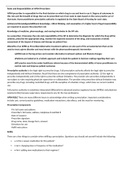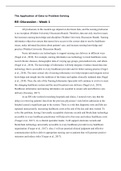APRN prescriber is responsible for the final decision on which drug to use and how to use it. Degree of autonomy in
this role and the breadth of drugs that can be prescribed vary from state to state based on the nurse practice act of
that state. Nurse practitioner prescriptive authority is regulated by the State Board of Nursing for each state.
•Advanced KnowledgeoAdditional knowledge, critical thinking, and assumption of a higher level of legal responsibility
are required to assume the prescriber role
Knowledge of medicine, pharmacology, and nursing intertwine in the NP role
As a prescriber, it becomes the role and responsibility of the NP to determine the diagnosis for which the drug will be
ordered, prescribe the appropriate drug, monitor the expected outcome of the drug, and incorporate a holistic
assessment of the impact of disease and therapy on patient lives
•Benefits of an APRN as PrescriberoAlternative treatment options are also part of the armamentarium that can be
used to treat a given disorder and may interact with the pharmacotherapeutic intervention
oAPRN look at the big picture and consider alternative treatment options and lifestyle changes
oPatients are looked at in a holistic approach and include the patient in decision making regarding their care.
oNP practice may thrive under healthcare reform because of the demonstrated ability of nurse practitioners to
control costs and improve patient outcomes
Prescriptive authority is the legal right to prescribe drugs. Full prescriptive authority affords the legal right to prescribe
independently and without limitation. Recall that there are two components of prescriptive authority: (1) the right to
prescribe independently and (2) the right to prescribe without limitation. The provider who prescribes independently is
not subject to rules requiring physician supervision or collaboration. The provider who prescribes without limitation may
prescribe any drugs, including controlled drugs, with the exception of schedule I drugs, which have no current medical
use.
Full practice authority is sometimes interpreted differently for advanced practice registered nurses (APRNs) and physician
assistants (PAs) because supervisory requirements vary for the two professions.
APRN ROLE There are many different issues to acknowledge when writing a prescription. Important considerations
include cost, current practice guidelines, medication interactions, side effects, and the need for monitoring.
Prescription Components
-Pt's full name and address
-Prescriber's full name, address, telephone # and DEA #
-Date of issuance
-Prescriber signature
-Drug name, dose, dosage form, amount
-Directions for use
-Refill instructions
Refills
There are a few things to consider when refilling a prescription. Questions you should ask yourself include the following:
• Is this a newer medication for this patient?
• Am I changing dose or frequency of the medication?
• Am I adding new medications to their regimen?
, • Is the patient having undesired side effects?
• When do I expect to follow up with this patient?
• If the patient is requesting a refill by telephone, when was the last time I saw this patient? Do I need to see the
patient again before refill?
• Is this a schedule II medication?
Promoting positive drug therapy outcomes requires a thoughtful and deliberate proactive approach to medication
management. In this chapter we explore ways the provider can improve patient outcomes. Emphasis is placed on
monitoring therapy, promoting adherence to therapy, and educating the patient.
Patient Teaching for Drug Monitoring
There are three primary reasons for drug monitoring: (1) determining therapeutic dosage, (2) evaluating medication
adequacy, and (3) identifying adverse effects.
When testing is needed for monitoring, include the following when providing patient teaching.
What: What test is needed?
o Patients like to know what test is needed. Rather than telling them that a blood test is needed, let them
know the type of blood test (e.g., a test of thyroid function or cholesterol levels).
When: When is testing required?
o Testing can disrupt normal routines. Patients need to know, in advance, how often testing is needed so
they can make plans.
Where: Where will testing take place?
o In some practices, testing takes place at locations other than the primary clinic. Patients who are
unfamiliar with the area need directions to the testing site and where to go after arrival.
Why: Why is testing necessary?
o Testing is often expensive and disruptive to daily lives. These barriers are common reasons that patients
miss appointments. If they understand the need for testing, they are more likely to adhere to testing
schedules.
How: How does the patient prepare for testing?
o Some tests require special preparation. For example, many blood tests require fasting. If exercise testing
is needed, patients should be told to bring comfortable shoes. It is important to let patients know of
anything they need to do prior to arrival.
Best Practices in Developing Written Patient Education Materials
Practice Rationale
Limit content Focus on main points. Include only the most important-to-
know content.
Place important information first People tend to remember the first things they read and may
,Best Practices in Developing Written Patient Education Materials
Practice Rationale
become distracted toward the end.
Write in active voice Active voice is more direct. Passive voice is less dynamic and
may be confusing.
Include adequate white space White space does not contain text or images. White space
makes the page feel less cluttered and less overwhelming.
Use meaningful illustrations Illustrations are a useful way to break up text. Select images
or drawings that have a purpose or that reinforce a point in
the handout.
Avoid professional terminology Use common terms in short, simple sentences that patients
can easily understand.
Check for readability Materials should be written at a lower education level that
can be understood by most patients. Information for
increasing readability is available
at http://www.cdc.gov/healthliteracy/pdf/Simply_Put.pdf
In examining these, five primary patterns emerge. These are: (1) forgetfulness, (2) lack of planning, (3) cost, (4)
dissatisfaction, and (5) altered dosing. An honest and open discussion that respects both the patient and provider
perspectives can be an important facilitator to promoting positive outcomes. Individualized solutions that address the
specific patient's concerns are those most likely to be successful.
Managing Medication Therapy
In addition to the medication review undertaken at each patient encounter, a more comprehensive and deliberate
review is needed periodically (at least annually). This review should be approached with the intent purpose of
determining whether there are better options for medication therapy. Inherent questions that must be asked about each
drug include the following:
• Is each medication accomplishing its intended purpose?
• Is each medication still necessary?
o • Has the patient's condition changed?
o • Do adverse effects or risks outweigh the benefits that some drugs provide?
o • What would happen if some medications were no longer prescribed?
• What problems does each medication create for the patient?
o • Is a medication problem amplified by other drugs the patient is taking?
o • If a medication is necessary but problematic, are drugs with fewer adverse effects available?
, • If polypharmacy is an issue, are there ways to decrease the number of medications?
o • Will a combination drug simplify management?
o • Is a single drug available (and desirable) for management of two different conditions?
The Beers List identifies drugs with a high likelihood of causing adverse effects in older adults. Accordingly, drugs on this
list should generally be avoided in adults older than 65 years except when the benefits are significantly greater than the
risks. A partial listing of these drugs appears in Table 10.2. The full list, updated in 2019, is available online
at https://onlinelibrary.wiley.com/doi/pdf/10.1111/jgs.15767.
TABLE 10.2
Some Drugs to Generally Avoid in Older Adults
Drugs Reason for Concern Alternative Treatments
Analgesics
Indomethacin Risk of GI bleeding and acute renal Mild pain: acetaminophen, codeine, COX-2–
(Indocin) failure. Indomethacin is more prone selective inhibitors if no heart failure risk, short-
to affect the CNS than other NSAIDs. term use of low-dose NSAIDs
Ketorolac
(Toradol)
Chronic use of
non- –COX-2
selective NSAIDs
(e.g., ibuprofen,
aspirin
>325 mg/day)
Meperidine Not effective at usual doses, risk for Moderate to severe pain: morphine, oxycodone,
(Demerol) neurotoxicity, confusion, delirium hydrocodone
Tricyclic Antidepressants, First Generation
Amitriptyline Anticholinergic effects (constipation, SSRIs with shorter half-life, (e.g., paroxetine,
urinary retention, blurred vision), sertraline, fluvoxamine), SNRIs, or other
Clomipramine
risk for cognitive impairment, antidepressants
(Anafranil)
delirium, syncope
Doxepin
(>6 mg/day)
Imipramine
(Tofranil)
Antihistamines, First Generation
Chlorpheniramine Anticholinergic effects (constipation, Second-generation antihistamines, such as
(Chlor-Trimeton, urinary retention, blurred vision), cetirizine (Zyrtec), fexofenadine (Allegra), or



